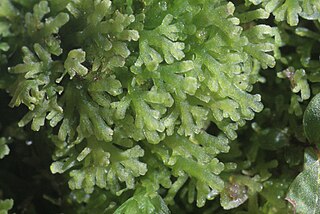
Metzgeriales is an order of liverworts. The group is sometimes called the simple thalloid liverworts: "thalloid" because the members lack structures resembling stems or leaves, and "simple" because their tissues are thin and relatively undifferentiated. All species in the order have a small gametophyte stage and a smaller, relatively short-lived, spore-bearing stage. Although these plants are almost entirely restricted to regions with high humidity or readily available moisture, the group as a whole is widely distributed, and occurs on every continent except Antarctica.

Jungermanniaceae is the namesake family of leafy liverworts. It is a group of small plants that are widely distributed. Several genera formerly included within the family are now classified in the Myliaceae or Solenostomataceae.

Jungermanniopsida is the largest of three classes within the division Marchantiophyta (liverworts).

Lepidoziaceae is a family of leafy liverworts. It is a group of small plants that are widely distributed.

Herbertaceae is a family of liverworts. The family consists of the genera Herbertus, Schisma and Triandrophyllum. The genus HerpocladiumMitten, 1873 was later merged into the genus Herbertus.

Blasiales is an order of liverworts with a single living family and two species. The order has traditionally been classified among the Metzgeriales, but molecular cladistics suggests a placement at the base of the Marchantiopsida.

Pleurozia is the only genus of liverworts in the family Pleuroziaceae, which is now classified in its own order Pleuroziales, but was previously included in a broader circumscription of the Jungermanniales. The genus includes twelve species, and as a whole is both physically distinctive and widely distributed.

Solenostomataceae is a family of liverworts in the order Jungermanniales.

Lophoziaceae is a family of liverworts belonging to the order Jungermanniales.

Acrobolbaceae is liverwort family in the order Jungermanniales.

Gymnomitriaceae is a liverwort family in the order Jungermanniales.

Cephaloziaceae is a family of liverworts.

Haplomitrium is a genus of liverworts.

Pallaviciniales is an order of liverworts.

Ptilidiales is an order of liverworts.

Lophozia is a genus of liverworts belonging to the family Lophoziaceae. The genus was first described by Barthélemy Charles Joseph Dumortier.

Anastrophyllaceae is a family of liverworts belonging to the order Jungermanniales.
Balantiopsidaceae is a family of liverworts belonging to the order Jungermanniales.

Cephaloziellaceae is a family of liverworts belonging to the order Jungermanniales.
Chonecoleaceae is a monotypic family of liverworts in the order Jungermanniales. It only contains the one genus Chonecolea.

















